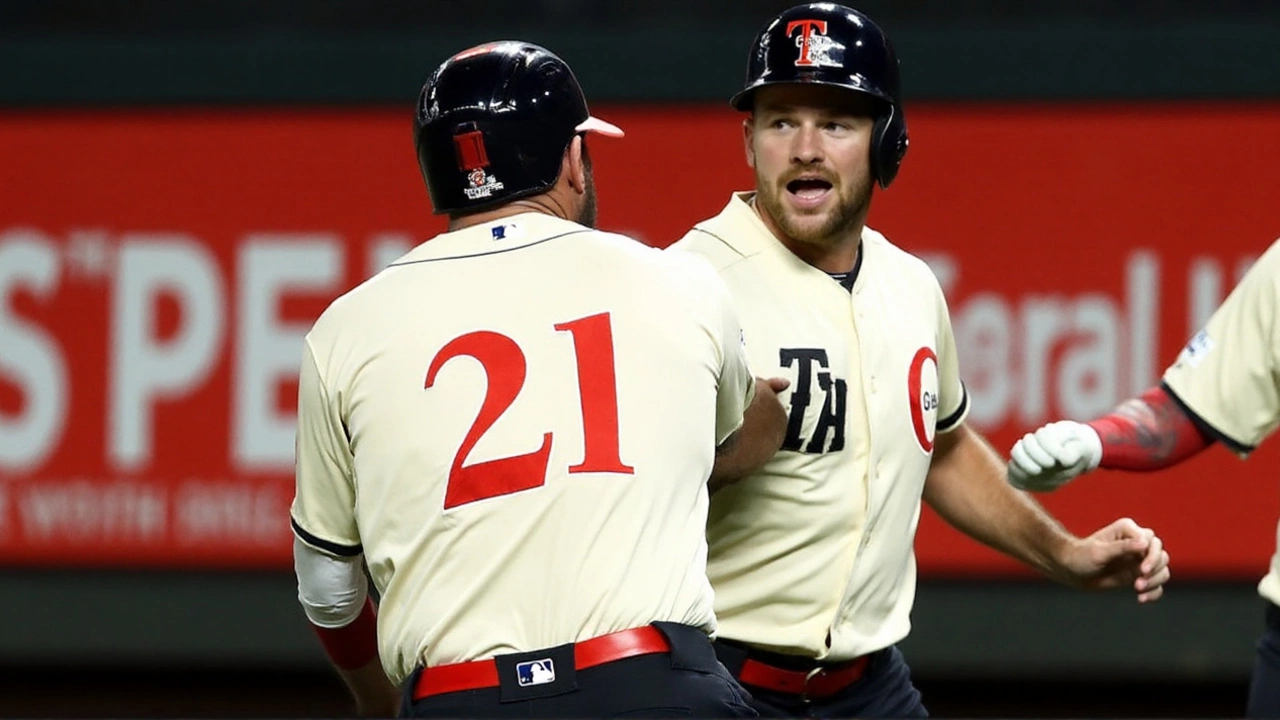Wyatt Langford’s profile fits a prop-friendly spot at Citi Field
Wyatt Langford has not needed eye-popping batting average to move the needle for bettors or the Rangers. He gets on base, he runs, and he keeps innings alive. He leads Texas in on-base percentage at .342 and in hits with 113, even with a modest .242 average. Among qualified hitters, that puts him 104th in average, 48th in OBP, and 75th in slugging. Not elite across the board, but more than enough to matter when you are staring at a slate of micro markets.
The steal threat is a big swing factor. On a 600 plate-appearance basis, Langford is pacing at 19.9 stolen bases, good for the 80th percentile. That speed does not just show up on a box score; it changes the math on runs scored props and total bases. A single and a steal turns into a scoring chance. It also nudges pitchers and catchers into mistakes, which turns into more fastballs and more hittable counts.
Tonight’s setup is simple but intriguing: Texas visits Citi Field for a 7:10 PM ET first pitch, with Jacob deGrom on the mound for the Rangers and rookie Jonah Tong starting for the Mets. The market opened with New York as an underdog and tightened toward Mets money; as of today, the Mets sit around -113, the Rangers around -109. That kind of coin-flip price with a rookie involved usually says two things: models are cautious on a small-sample arm, and bettors are split on whether Texas’s run prevention can overcome its uneven offense.
Zoom out and it tracks. Texas is scoring 4.3 runs per game, 21st in MLB. The Mets are at 4.7, 10th. But the Rangers have smothered opponents all season, allowing a league-low 3.7 runs per game. That defense and run prevention has kept them afloat when the bats go missing. In a prop context, that mix suggests two paths for Langford: either he benefits from a lower-scoring, tight game where one hit plus a steal is enough to cash a runs ticket, or he rides a potential total creeping upward if the rookie struggles and turns this into a traffic-heavy night.
The ballpark adds another layer. Citi Field is not a classic bandbox, but the left-field dimensions are friendlier than they used to be, with one of the shallower left-field fences in the league. Right-handed pull hitters can find carry there, especially on anything left up. Langford’s power output has been modest, and the market knows it, which is why his home run prop is out at a longer number. But the park still helps his doubles profile and the kind of skip-through-the-gap singles that turn into second base with a good jump.
Langford’s table-setting skill set has already shown up in how books are pricing his markets. The over or under on 0.5 runs is posted in the +115 to -150 range depending on the side. The hits prop at 0.5 is also drawing action, and with reason: a hitter who gets on base at a healthy clip, runs well, and often sees a rookie on the other side tends to grade out more favorably in projection systems. THE BAT X and other models like the matchup for Texas bats against Tong, who is making just his second big-league start. Inexperience at this level often means fewer solutions the second and third time through.
Put all of that together and you can see why the total has bounced between 7.5 and 8.5 across books. Several modeling runs project the over to hit close to 70 percent of the time in simulation. If you buy that, you are also buying more plate appearances, more base runners, and more chances for Langford to do one simple thing: cross the plate. That is why the runs market has become one of the most popular angles on his board tonight.

Odds, trends, and how to play Langford’s markets
The pricing tells a story. At -113, the Mets carry an implied win probability around 53 percent. The Rangers near -109 sit in roughly the same range after juice. That is not conviction; that is a tug-of-war. If you are weighing player props inside that, you are betting on micro edges: lineup position, baserunning, quality of contact, and how quickly a rookie settles in. Langford checks several of those boxes even without leaning on pure slug.
Recent betting trends sharpen the picture. Texas has been a steady run line team at +1.5, cashing 38 of its last 63 and kicking out a 17 percent ROI. On the other side, game totals have been friendly to Mets backers, with overs hitting in 46 of their last 82. You never bet a prop because of a team trend alone, but those signals line up with what models say about tonight’s scoring environment. A slightly higher total pushes Langford’s counting stats up at the margin.
Now, the props themselves. Here is what stands out based on form, matchup, and price.
- Over 0.5 runs (+115 side): At +115, the implied probability is about 46.5 percent. For a player with a .342 OBP, top-tier steals rate, and a rookie starter across the way, that is a fair plus-money swing. You are betting he reaches and someone behind him does their job once.
- Over 0.5 hits: The number will carry juice to the over given his contact track record, but with 113 hits on the season and a neutral-to-friendly park fit, this remains one of the lower-variance ways to back him. Even a single can snowball into a run with a steal or a wild pitch.
- Home run (+360): The price implies about a 21.7 percent chance he goes deep. With modest season-long power, this is a thinner path compared to runs or hits. The park tilt to left does help, and a rookie can occasionally leave one center-cut, but this is the definition of a longer shot for Langford’s profile.
- Total bases: Books often hang this at 1.5. If you like the contact plus speed combo but do not want to sweat a run scoring, total bases can be an alternative. Doubles are in play at Citi Field, and a pair of singles cashes the over the same way.
Matchup dynamics matter too. If Tong’s pitch count spikes early, the Mets bullpen becomes part of the handicap. A longer look at middle relief arms generally means more opportunities to see a comfortable pitch type in a second or third plate appearance. Conversely, if deGrom shapes the tempo and keeps this game tight, Rangers hitters may press for early offense, putting more emphasis on first and second trips through the order. Either way, Langford’s prop shape stays intact because it is driven by reach rate and speed, not just one-swing damage.
There is also the pacing angle. In higher total environments, you get more back-to-back baserunners and forced holds, which opens a lane for steals. Langford’s 80th-percentile steal pace is not a vanity stat; it is a lever. Pitchers who worry about the run game expand the zone or fall behind, and that spills into more lifted balls and clean hits on the next batter. If you are playing the over on 0.5 runs, you are effectively betting that chain reaction happens once.
Projections back the idea. THE BAT X and similar systems flag this as a favorable hitting spot for Texas due to Tong’s inexperience and the likelihood he sees the order multiple times without a deep arsenal look. That does not mean a blowup inning is guaranteed; it means probability shifts toward more Rangers baserunners. In prop terms, that is all you need to justify a plus-money run price or a juiced hits over on a key bat.
Market movement is worth watching right up to first pitch. If Mets money keeps trickling in and the total holds closer to 8.5, books may shade Langford’s runs and total bases even further. If the total dips to 7.5 across the board, you could see small discounts on runs markets. Shop those swings. Micro-moves matter more on a 0.5 line than they do on a full-game spread.
On the narrative side, deGrom’s return to Citi Field is a subplot, but it does feed the tempo conversation. If he dominates early and runs a low pitch count, Texas will push to scratch first. That urgency favors hitters with on-base and speed, not just power. It is another subtle tailwind for Langford’s safer props.
Want to quantify it a bit more? Think in trips. If Langford gets four plate appearances in a game that leans to the over, a .342 OBP suggests he reaches roughly once or twice, with some chance of an extra-base hit baked in. Add his steal rate and the probability he ends up in scoring position at least once rises. You are not betting a certainty; you are buying multiple paths to one event.
One last detail: the park’s left-field profile. While the fence helps pull power, it also turns firm line drives into doubles when corner outfielders misplay the carom. For a hitter still building the over-the-fence profile, that is quietly more useful than the home run chase. It gives you outs to cash total bases and sets up the run prop via an immediate scoring position spot.
Practical checklist before you place anything: confirm Langford is in the starting lineup and note his lineup slot, scan for late weather notes that could suppress carry or running conditions, and compare prices across books. If the runs over drifts above +120, the value call strengthens. If it sinks to even money or worse, the hits over may be the cleaner path.
To tie the threads: the market frames this as a near coin flip, models suggest scoring can pop, and a rookie starter often boosts base traffic. In that world, Langford’s combination of reach rate and speed gives his most basic prop markets a slight edge over the flashier ones. If you are playing just one angle, the over 0.5 runs at plus money is the simplest way to ride the profile. If you want the safer route with less variance, the over on 0.5 hits remains the steady choice.
Pick your lane based on price. Do not force the home run number just because it looks fun. Let the matchup guide the decision: baserunners, pressure, mistakes, and one cross of home plate. That is how you translate scouting notes into actionable betting slips on Wyatt Langford props.





Tulis komentar